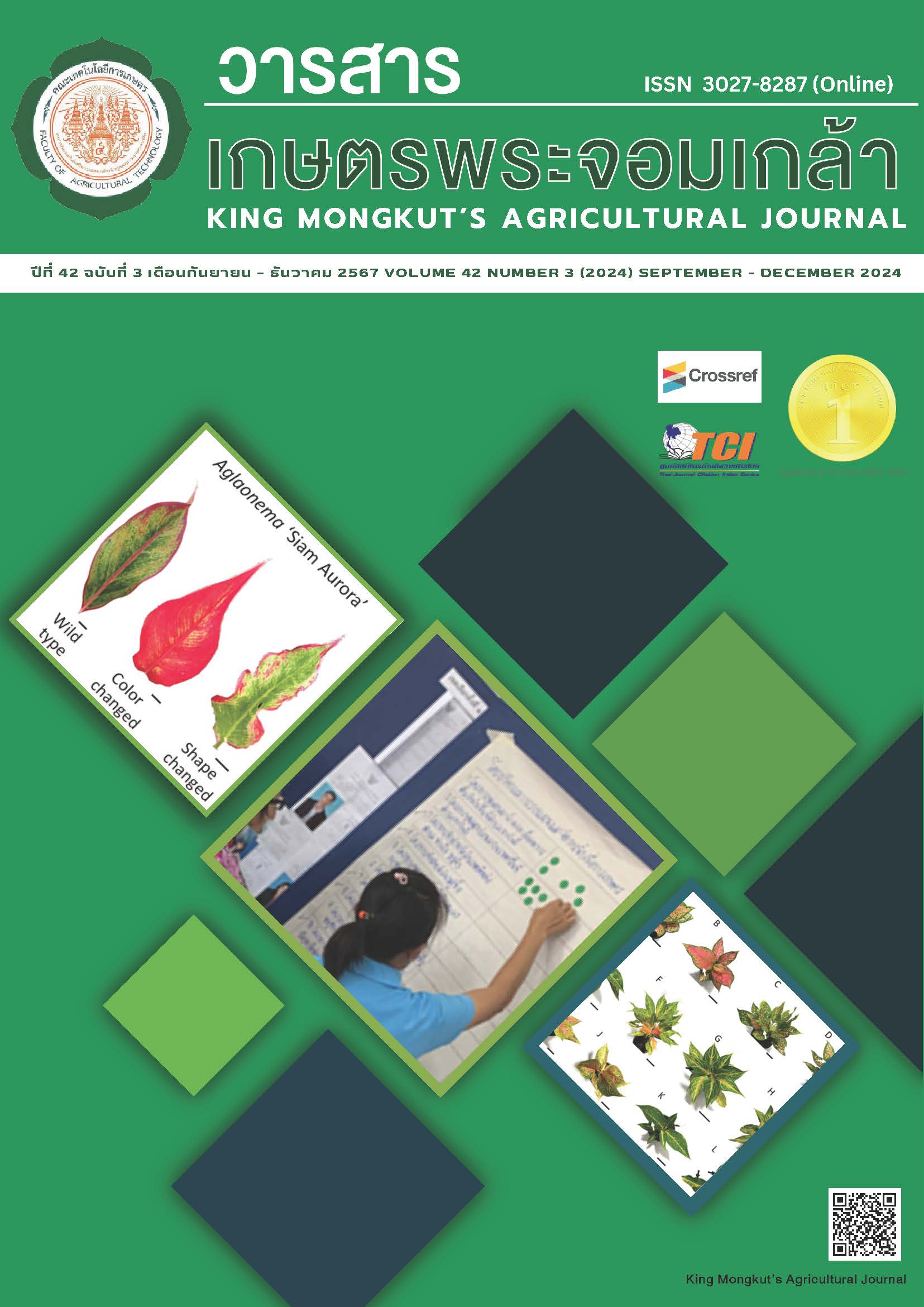ผลของระดับโปรตีนและพลังงานต่ออัตราการเจริญเติบโตและคุณภาพซาก ของไก่ตอนลูกผสมพื้นเมืองประดู่หางดำ
Main Article Content
บทคัดย่อ
การวิจัยครั้งนี้มีวัตถุประสงค์เพื่อศึกษาระดับที่แตกต่างกันของโปรตีน (CP) และพลังงาน (ME) ต่ออัตราการเจริญเติบโตและคุณภาพเนื้อในไก่ตอนลูกผสมพื้นเมืองประดู่หางดำ แผนการทดลองแบบ 2x2 Factorial in CRD ใช้ไก่ลูกผสมประดู่หางดำ ทำการตอนที่ อายุ 4-5 สัปดาห์ (ส.) ช่วงแรกเกิดถึง 5 ส. ใช้อาหารทางการค้า และช่วงอายุ 5-12 ส. ให้ได้รับอาหาร 4 สูตร คือ สูตรที่ 1 CP 19% และ 3.0 kcal ME/g สูตรที่ 2 CP 19% และ 3.3 kcal ME/g สูตรที่ 3 CP 21% และ 3.0 kcal ME/g สูตรที่ 4 CP 21% และ 3.3 kcal ME/g ช่วงอายุ 13-20 ส. ต่างกัน 4 สูตร คือ สูตรที่1 CP 17% และ 3.0 kcal ME/g สูตรที่ 2 CP 17% และ 3.3 kcal ME/g สูตรที่ 3 CP 19% และ 3.0 kcal ME/g และ สูตรที่ 4 CP 19% และ 3.3 kcal ME/g บันทึกการเจริญเติบโตและทำการชำแหละที่อายุ 12 16 และ 20 ส. เพื่อหาความนุ่มและปริมาณไขมัน จากผลการวิจัยพบว่าอายุ 5-12 ส. และ 13-16 ส. ไก่ตอนลูกผสมพื้นเมืองประดู่หางดำที่ได้รับอาหาร CP และ ME ที่แตกต่างกันไม่ส่งผลต่อสมรรถภาพการผลิต แต่ที่ช่วงอายุ 17-20 ส. พบว่า ไก่ตอนที่ได้รับ ME 3.3 kcal ME/g ส่งผลทำให้มีน้ำหนักตัวเพิ่ม (273.02 vs. 471.17 กรัม; P<0.05) และอัตราการเจริญเติบโต (9.75 vs. 14.89 กรัม; P<0.05) มากกว่า เมื่อเทียบกับเมื่อได้รับ ME 3.0 kcal ME/g ด้านการเปลี่ยนอาหารเป็นน้ำหนัก (7.63 vs. 4.70 ; P<0.05) และต้นทุนค่าอาหารในการเพิ่มน้ำหนัก (110.70 vs. 71.59 บาท/กิโลกรัม; P<0.05) มีค่าที่ต่ำในไก่ตอนที่ได้รับ ME 3.3 kcal ME/g เทียบกับ 3.0 kcal ME/g อย่างมีนัยสำคัญทางสถิติ สำหรับคุณภาพเนื้อของไก่ตอน พบว่าที่อายุ 16 ส. ไก่ตอนที่ได้รับอาหาร CP 21% ช่วง 5-12 ส. และ CP 19% ช่วง 13-16 ส. ร่วมกับ ME 3.0 Kcal/g มีค่าแรงตัดเฉือนส่วนเนื้ออกต่ำที่สุด (4,018.69 N) ที่อายุชำแหละที่ 20 ส. ไก่ตอนที่ได้รับ ME ต่ำมีค่าแรงตัดเฉือนส่วนเนื้อสะโพกน้อยกว่ากลุ่มที่ได้รับ ME สูงอย่างมีนัยสำคัญ (1,539.28 vs. 1,725.77 N; P<0.05) ผลการศึกษาด้านปริมาณไขมันในเนื้อไก่ตอน พบว่า ที่อายุ 20 ส. ช่วง 5-12 ส. ไก่ตอนกลุ่มที่ได้รับอาหาร CP 19% และช่วง 13-20 ส. ที่ได้รับอาหาร CP 17% ME 3.3 Kcal/g มีปริมาณไขมันส่วนเนื้ออก (5.06%; P<0.05) มากที่สุดอย่างมีนัยสำคัญ และที่อายุชำแหละ 12 และ 20 ส. พบว่า ไก่ตอนกลุ่มที่ได้รับอาหาร CP 19% ช่วง 5-12 ส. และ CP 17% ช่วง 13-20 ส. ร่วมกับ ME 3.0 Kcal/g มีปริมาณไขมันส่วนเนื้อสะโพก มากที่สุด (17.32% และ 19.99%; P<0.05) จากการศึกษาสูตรอาหารที่เหมาะสมสำหรับไก่ตอนลูกผสมพื้นเมืองที่อายุ 5-12 ส. มีต้นทุนค่าอาหารในการเพิ่มน้ำหนักต่ำ แนะนำสูตรที่ 4 (CP 21% ME 3.30 kcal ME/g) อายุ 13-20 ส. สูตรที่ 4 (CP 17% ME 3.0 kcal ME/g) รวมทั้งแนะนำให้เชือดที่อายุ 20 ส. เนื่องจากมีปริมาณไขมันสะสมในเนื้อไก่ตอนมากที่สุด
Article Details

อนุญาตภายใต้เงื่อนไข Creative Commons Attribution-NonCommercial-NoDerivatives 4.0 International License.
วารสารเกษตรพระจอมเกล้า
เอกสารอ้างอิง
Cason, J. A., Fletcher, D. L., & Burke, W. H. (1987). Effects of caponization on broiler growth. Poultry Science Journal, 67, 979–981.
Fenneli, M. J., Radecki, S. V., Proudman, J. A., & Scanes, C. G. (1996)., The suppressive effects of testosterone on growth in young chickens appears to be mediated via a peripheral androgen receptor; studies of the anti-androgen ICI 176,334. Poultry Science Journal, 7(6), 763-766.
Hubbard. (2019). Parent Stock: Guide and Nutrient Specifications. Retrieved from: https://www.hubbardbreeders.com/media/ premium_guide_and_nutrient_specifications.pdf
Maliwan, P., Khempaka, S., & Molee, V. (2017). Evaluation of various feeding programmes on growth performance, carcass and meat qualities of Thai indigenous crossbred chickens. S. Afr. Journal of Animal Science, 47, 16-25.
Mast, M. G., Jordan, H. C., & Macneil, J. H. (1981). The effect of partial and complete caponization on growth rate, yield and selected physical and sensory attributes of cockerels. Poultry Science Journal, 60, 1827–1833.
Muriel Duran, A. (2004). The effect of caponization on production indices and carcass and meat characteristics in free-range Extremena Azul chickens. Spanish Journal of Agricultural Research, 2, 211–216.
Ouisongnoen, C., (2006). Comparison of hormone implanted chicken and caponization lateral. Journal of Animal Science, 17, 10-13. (in Thai).
Rattanawaraha, A. (1993). Native Chicken. 5th ed. Thai Agriculture Publisher. (in Thai).
Snapir, N., Robinzon, B., & Shalita, B. (1983). The involvement of gonads and gonadal steroids in the regulation of food intake, body weight and adiposity in the White Leghorn cock. Pharmacology Biochemistry Behavior Journal, 19, 617–624.
Songsee. O., Tangtaweewipat, S., Cheva-Isarakuland, B., & Moonmanee, T. (2018). “Laparoscopic vacuum testectomy technique for castration Royal Project Bresse chickens on highland of Thailand,”. Songklanakarin Journal of Science and Technology SJST, 2018-0221, 6-23.


